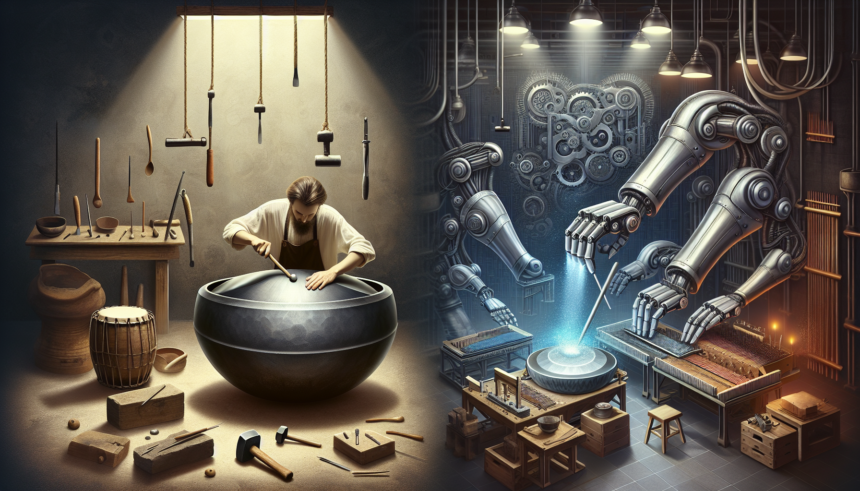The handpan, often referred to as a hang drum, is a captivating and ethereal musical instrument that has gained considerable popularity over the past two decades. This imaginative and resonant instrument, comprising a convex steel dish with carefully hammered notes, produces a mesmerizing sound that attracts musicians and listeners alike. The creation of a handpan involves significant craftsmanship and skill. The methods of handpan making can be broadly categorized into traditional and modern techniques, each with its own set of characteristics, benefits, and challenges.
Traditional Handpan Making Methods
Traditional handpan making is an intricate and hands-on process that has roots in early steel pan making techniques. Below are the key components of this approach:
1. Hand Hammering:
One of the hallmarks of traditional handpan making is the extensive use of hand hammering. This process involves meticulously shaping and tuning the steel shells by striking them with a hammer. Experienced artisans rely on their senses of touch and hearing to achieve the desired notes and tonal quality. This method ensures that each handpan is a unique, one-of-a-kind instrument.
2. Nitrocarburizing:
Nitrocarburizing involves subjecting the steel to a controlled heat treatment process that enhances its hardness and durability. This treatment, typically executed in a special furnace, helps improve the steel’s resistance to corrosion and wear, making the handpan more resilient over time.
3. Acoustic Testing:
Traditional handpan makers often use their trained ears to fine-tune the instrument. This process, called acoustic testing, requires a deep understanding of the acoustic properties of steel and how different hammer strikes influence the sound. Artisans tap and listen to the instrument repeatedly, making incremental adjustments until the desired pitch and timbre are achieved.
The traditional approach to handpan making is labor-intensive and time-consuming. It requires years of experience to master the precise techniques needed to produce high-quality instruments. However, the resulting handpans are often praised for their rich, organic sound and individual character.
Modern Handpan Making Methods
With advancements in technology and materials science, modern handpan making methods have emerged, offering new possibilities for production. Here are some key aspects of these contemporary techniques:
1. Hydraulic Presses and CNC Machinery:
Rather than relying solely on hand hammering, modern handpan makers often utilize hydraulic presses and CNC (Computer Numerical Control) machinery to shape the steel shells with precision. These machines can replicate specific designs and dimensions consistently, reducing the variability between different instruments. This approach also speeds up the production process, allowing makers to produce handpans more efficiently.
2. Advanced Heat Treatments:
Advanced heat treatments, such as cryogenic tempering, have been integrated into modern handpan production. These treatments involve exposing the steel to extremely low temperatures to enhance its structural properties further. The result is a more stable and robust instrument with improved tuning stability over time.
3. Digital Tuning and Analysis:
Modern handpan makers often employ digital tools and software to aid in the tuning process. Spectrum analyzers and other specialized software can provide detailed insights into the frequencies and overtones produced by the instrument. This data-driven approach allows for more precise tuning and consistency, ensuring that each handpan meets specific tonal standards.
While modern methods offer several advantages, such as increased efficiency and consistency, they may lack the personal touch and unique character that traditional techniques impart to each instrument. Nonetheless, contemporary handpans are known for their reliability, precise tuning, and often more affordable price points.
Comparison of Traditional and Modern Methods
Both traditional and modern handpan making methods have their strengths and limitations. The choice between these approaches often depends on the preferences of the maker and the desired qualities of the final instrument.
Sound Quality and Character:
Traditional handpans are celebrated for their warm, organic tones and unique character. Each instrument produced through hand hammering carries the individual touch of the artisan, resulting in subtle variations in sound. On the other hand, modern handpans offer more consistent and precise tuning, appealing to musicians seeking specific tonal qualities.
Production Time and Efficiency:
The traditional method is highly labor-intensive and time-consuming, requiring months of work to produce a single handpan. Modern techniques significantly reduce production time, enabling makers to meet higher demand and offer more competitive pricing.
Craftsmanship and Personal Touch:
Traditional handpan making is often regarded as an art form, with each instrument reflecting the skill and creativity of the artisan. Modern methods, while efficient, can lack the personal touch and artistic expression associated with hand-hammered instruments.
Durability and Tuning Stability:
Advanced heat treatments and digital tuning techniques utilized in modern handpan making enhance the instrument’s durability and tuning stability. Traditional handpans, although unique and expressive, may require more frequent maintenance to retain their optimal sound.
Conclusion
In conclusion, the realm of handpan making encompasses both traditional and modern methodologies, each contributing distinct qualities to the final instrument. Traditional handpans, forged through hand hammering and the artisan’s skilled craftsmanship, carry an unparalleled sense of individuality and organic sound. Meanwhile, modern handpans leverage technological advancements to achieve consistency, precise tuning, and enhanced durability.
Ultimately, the choice between traditional and modern handpan making methods lies in the preferences of the musician and the desired attributes of the instrument. Some may gravitate towards the unique charm and character of traditional handpans, while others may appreciate the precision and reliability offered by modern techniques. Both approaches continue to evolve, ensuring that the magic of the handpan endures for generations to come.
FAQs
1. What is the primary difference between traditional and modern handpan making methods?
The primary difference lies in the techniques and tools used. Traditional methods focus on hand hammering and acoustic testing, while modern methods utilize hydraulic presses, CNC machinery, and digital tuning for consistency and efficiency.
2. Are traditional handpans more expensive than modern ones?
Generally, yes. Traditional handpans are often more expensive due to the labor-intensive process and the unique craftsmanship involved. Modern handpans, being produced more efficiently with technological aids, can be more affordable.
3. Can modern handpans achieve the same sound quality as traditional handpans?
Modern handpans can achieve high-quality sound and precise tuning, but they may lack the unique character and organic tones that come from the hand hammering process of traditional methods. Sound preferences vary among musicians, making each type appealing for different reasons.
4. How long does it take to make a traditional handpan?
Creating a traditional handpan can take several months, as the process involves meticulous hand hammering, tuning, and numerous adjustments to achieve the desired sound. In contrast, modern methods can significantly reduce the production time.
5. Are there any maintenance differences between traditional and modern handpans?
Yes, traditional handpans may require more frequent maintenance to maintain their sound quality due to their handmade nature. Modern handpans, benefiting from advanced heat treatments and precise tuning techniques, often have greater tuning stability and require less frequent maintenance.





